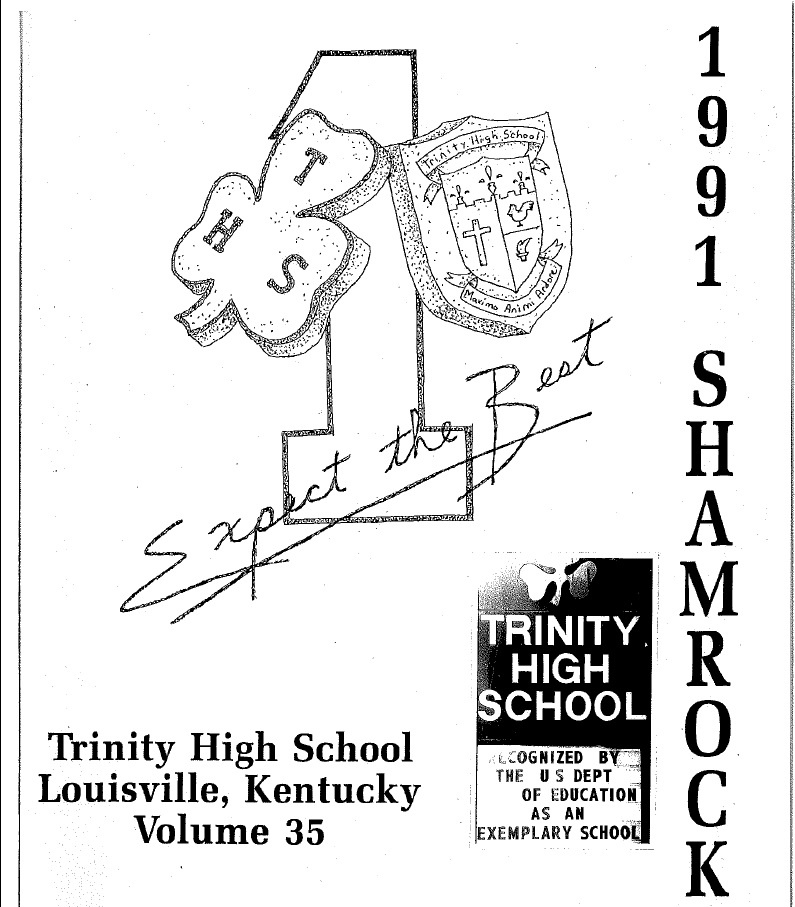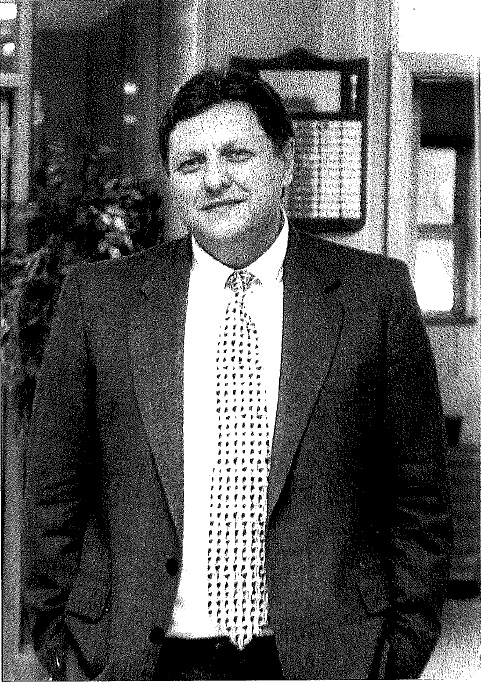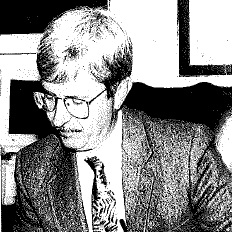Strategic Planning and the Coming of President/Principal Model (1990-99)
July 23, 2019 | General
Chapter 5
Strategic Planning and the Coming of President/Principal Model (1990-99)
With the expansion of building and grounds moving along, one of the proudest moments for Trinity at the beginning of the decade was being recognized as a national Blue Ribbon School of Excellence in 1991. This award, presented by the U. S. Department of Education “identified and gave public recognition to outstanding public and private schools.”
Flaig had long sought this award for Trinity so that we could “measure ourselves” against the best in the nation.
English department chair Frank Ward was appointed to lead the team during its application process. The award criteria demanded strong leadership, a challenging learning environment and evidence of achievement and responsible behavior. Ward prepared a 36-page application and coordinated the visit of the site team.
The second plan for 1995-98 included a 15-year “vision document” to give direction and perspective through 2010. It called for more construction and outlined 10 pillars that together accounted for all phases of Trinity’s organizational structure:
The Community of Faith
Academics
Student Services
Student Activities and Athletics
Faculty and Staff
Technology
Advancement
Alumni Communications, Community Relations and Marketing
Governance, Administration and Finance
Buildings and Facilities
Everything that Trinity did was now tied to one of these pillars. They constituted the organization of Flaig’s quarterly reports to the School Board, making the administration accountable for progress in each area.
The school continues even today using these triennial strategic plans. Rob Mullen ’77, an administrator under Flaig and later school president, commented: “Our strategic planning process has been the single most important endeavor in producing the success we enjoy. We force ourselves to fight complacency and to keep the students as the focal point. It has made the school administration more accountable and allowed us to attract bright qualified volunteers to our School Board.”
The most significant result of the strategic planning process was the change in Trinity’s relationship with the Archdiocese. After reading the initial reports of the strategic planning committee, Archbishop Thomas Kelly proposed that Trinity become “sponsored” by the Archdiocese rather than owned and operated as it had been for nearly 40 years. Kelly’s idea was unique nationally, perhaps making Trinity the first diocesan high school with this arrangement.
Under this plan, Trinity’s future would rest with the School Board, administration, faculty and staff. With the signing of the December 28, 1993 sponsorship agreement, Trinity became an incorporated institution, completely autonomous in most decision-making from the Archdiocese.
The Trinity High School Foundation Inc., a corporation composed of parents, alumni and friends, took responsibility for the school’s assets. A new corporation, Trinity High School Inc., d.b.a. Trinity High School, was initiated with the primary responsibility of managing the school’s day-to-day operations.
Under the sponsorship agreement, the Archdiocese continued to provide teacher benefits and some tuition assistance. It also retained authority over religious instruction, the approval of the selection of the president, approval of an ex-officio member representative to the Board and final approval of any change in the basic character and mission of the school.
The School Board became a jurisdictional policy board with final authority for all areas of educational policy and administration. The Foundation Board retained its purpose of assisting the funding of facilities, management of the endowment and other related activities. The Foundation Board also held the school’s real estate and endowment fund assets.
As Trinity began its 40th year, a dedication of the new Alumni Hall was held on January 15, 1994. Representatives from each of the decades of the school’s history were invited and marveled at the new cafeteria, administrative offices and the sight of a beautiful donor wall marking the end of a major campaign whereby donors could buy a “brick” to show their support of their alma mater.
By 1998, computers had been placed in every classroom and teachers had received instruction in basic skills and concepts with the promise of continued improvement in their usage and development. That same year, alumnus Michael Price ’66 was hired as Trinity’s first webmaster.
Teachers found that computers were helpful as a learning tool in the classroom and students found them enlightening. Flaig took pride in the idea of Trinity as a “Cyber School” and reveled in the local and national publicity. He was determined to keep the school on the cutting edge of technology during his tenure.
Computers weren’t the only technology that Trinity experienced during this time. Video broadcasting in the classroom had begun with Greg Sysol H ’03 and Rev. Ron Domhoff team-teaching a course in Broadcast Journalism. By 1998, Trinity had purchased a video production system which was the heart of a campus television facility comprising two studios, a sound booth, numerous cameras and two video toaster systems.
Trinity was the only area school with the system, which allowed students to learn production and editing on the same equipment television networks used. Students used the equipment to produce the school’s daily Trinity Television news broadcast, along with other special projects.
The system was so professional that the local CBS network affiliate WLKY-TV toured the Trinity studios and found them to be advanced enough to broadcast a locally originated newscast in the event the station was ever taken off the air.
At the same time, Trinity also made some changes to its curriculum. The academic program comprised four Programs of Study – Advanced, Honors, Academic and Traditional. Even though ability-grouping had always been present since its founding, Trinity ensured that with appropriate placement, each student would be challenged to his ability with real prospect of academic success and achievement.
Perhaps the area that changed the most was the Advanced Program, which was headed by Frank Ward. Advanced Program students were required to take at least five subjects at the most difficult level of difficulty (LOD). Continued participation required maintaining at least a B average in these classes with no single grade below 80.
Students not initially placed in the program could apply for admission. The curriculum explored various common themes in selected study areas and was enhanced by support activities, a community service program and a cultural fine arts component.
Membership in the National Beta Club began in 1998 to compliment the time-honored National Honor Society which had been at the school since the 50s. Ward said his challenge was clear. “I think what has changed in the environment of education is there are so many more demands on students than when I first started teaching. Very gifted students are encouraged by their parents, by this school, by society to be involved, to take leadership roles and to be visible.”
In addition, Trinity applied and was accredited by the Southern Association of Colleges and Schools in December, 1996. Led by Winkler’s efforts, this accreditation was a major achievement for the school, as it was not only accredited by the state of Kentucky, but also by the most recognized secondary accreditation agency in the Southeastern part of the country.
While Ward and others were rebuilding Trinity’s academics, Peter Flaig turned his attention to the physical plant. His ability to leave a legacy of new structures was facilitated over the years by large monetary donations. The most significant came from Robert Woodrow “Buck” Marshall who on December 1, 1998 gave $500,000 as part of a new fund-raising campaign begun that year. This gift was the single largest gift Trinity had ever received. In giving it, Marshall commented, “Trinity has always been a beacon of light in this community.” His real estate office was located next to the campus and he had ample opportunity to observe what was happening there and obviously liked what he saw.
Todd Hollenbach ’57 had encouraged Marshall to make the donation. He also persuaded Dennis Lampley, the athletic director, to approach Mr. Marshall. The two became good friends. In making the gift, Marshall invited Lampley to his office and presented him with a shirt embroidered with “Marshall Realty.” He told Lampley that he wanted him to always remember the day that he got “the shirt off my back.”
Marshall’s generous gift was used to build the R. W. Marshall Sports Center at the rear of the campus along Westport Road (see History of Athletic Department for additional details).
The man responsible for its construction was Glynn Stengel ’67. As far back as 1985, Stengel had been involved in various remodeling and refurbishing projects at his alma mater. He would later explain his involvement was tied to his experience as a student. “There were teachers and priests here who gave me some very good guidance and kept me out of trouble, so it was kind of pay-back for everything they did for me…you graduate from Trinity but you never really leave,” Stengel commented.

Stengel would later head up the construction of the new Shamrock Hall, which opened in August 2000 as Trinity’s second gym. The new gym enhanced Trinity’s ability to offer a greater variety of intramural sports and also became the home for the Health and Physical Education Department.
These two athletic buildings were built at a cost of $2.3 million. The Shamrock Spirit Campaign raised $3.3 million, with the remainder added to the endowment. A television studio, nine new classrooms and an elevator found their home in an addition to Floersh Hall that opened in 2001.
As the new millennium was about to begin, Trinity lost several of its early leaders.
Teachers Harry Hill (1987), Fr. Al Moore (1989), Ed Nolan (1991), Fr. Harry Jansing (1992), “Jeep” Quire (1993), Rev. Kevin Caster (1997) and former principal Fr. Thomas Duerr (1994) all entered eternal life.
As well, two retirements significantly altered the Trinity administration. Evelyn Fultz, who had been the secretary for every principal and president since the school began, retired in 1995 after 42 years of faithfully serving the school. Later, she would become the first woman inducted into Trinity’s Hall of Fame.
A year later, David Kelly, who had served the school as a coach, athletic director, disciplinarian and later the founder of the school’s counseling department, retired. He noted, “Fr. Duerr had the foresight to see that a counseling department was necessary and it started with me giving personal counseling.” Longtime science teacher Joe Bobrowski replaced Kelly as the department chair.
Illness also struck the school’s president, Peter Flaig. In 1999, he underwent open heart surgery to repair complications from a blood infection. In June he told the School Board, “I find myself with a temporarily diminished attention span, energy level and power of concentration.” He continued with his duties on a limited basis until his strength returned.
Within a year Flaig knew that physically he had to retire even though he was only 52. He wrote to the School Board, “The time has finally come to make a change, a change that will be good for me and good for Trinity. I leave Trinity with nothing but hope and positive wishes for continued growth and success.”
In his last report to the Board, he acknowledged pride in the resources he had developed – a growing enrollment, a building boom and a major effort to refurbish older facilities. He left Trinity in the black financially with a growing endowment.






